30 October 2023
![]() 14 mins Read
14 mins Read
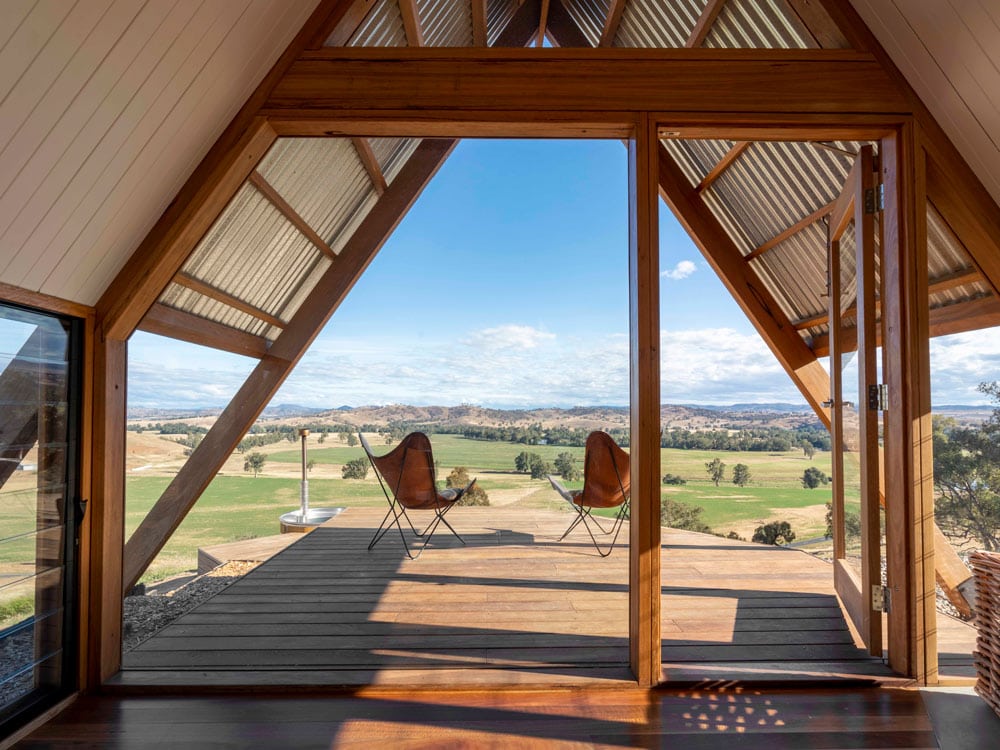
Here are the top 8 regional stays that made it into positions 19 to 27 of our coveted list of 100 unique stays. Head here to read the full list and start planning your next escape.
I awake in the middle of the night to a view of the inky-black sky filled with stars. The moon lights up the inside of my partially glass-walled eco hut on Kimo Estate and I see the embers are still aglow in the fireplace from earlier that night when I sat by its warmth with a tall glass of local Borambola Wines shiraz. I marvel at how much brighter the moon shines out herein the absence of all other light sources. I pull the sheets up higher, inch further down into bed and slowly drift back to sleep. This is just one of many memorable moments from my stay in JR’s Hut, one of three eco huts on the property (with more on the way), spaced kilometres apart for privacy and each with the added luxury of a wood-fired hot tub.
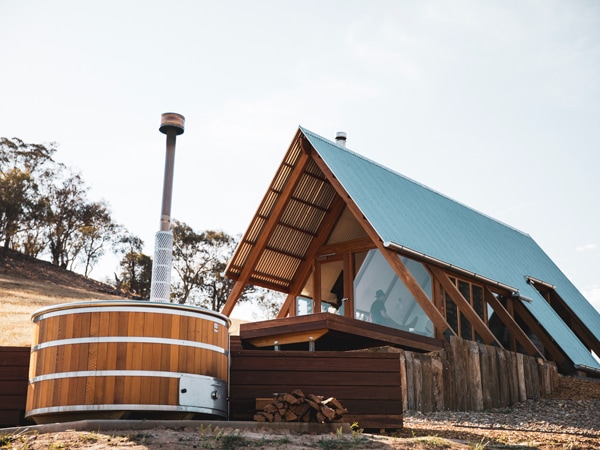
The beautiful architecture of JR’s Hut at Kimo Estate (image: Destination NSW).
The hut – which is far too modest a term to use for such a beautiful, architecturally designed timber structure – is pitched high on the hilltop of a vast working sheep and cattle farm located about a 3.5-hour drive from Sydney and 10 minutes from Gundagai. From the verandah I see the Murrumbidgee River snake its way through the patchwork of green-and yellow farmland below. Cockatoos take up residence in a nearby tree and the muffled bleats of sheep grazing below, which appear as fluffy dots from this distance, are carried on the wind. The 360-degree views are one of the eco hut’s best features, only rivalled by the simple, yet elegant interior offering. A queen-size bed is the focal point of the studio-like cabin with the aforementioned log fireplace off to the side and two chairs arranged to soak up the views, but it’s the rainfall shower that really takes centre stage. The glass wall gives the illusion of showering outside and I lather up the Leif body products under the steaming hot water as I take in the views of the farm below.
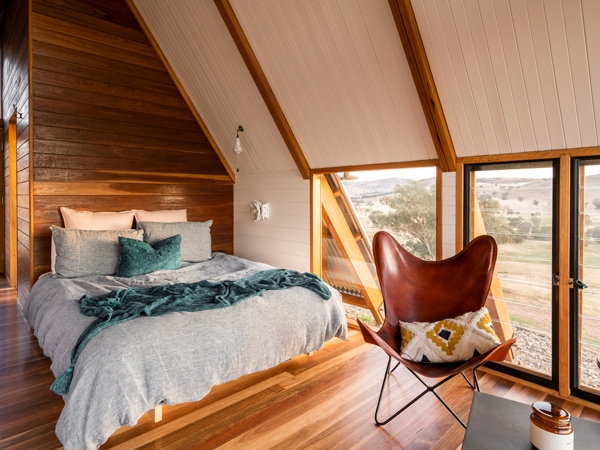
Wake up to the countryside at Kimo Estate (image: Matt Beaver).
A gourmet breakfast is included in my stay and I find homemade baked beans, farm-fresh eggs, local bacon, and cherry tomatoes soaked in balsamic dressing along with a loaf of fresh sourdough bread in the solar-powered fridge outside. I cook it up on the barbecue and camp stove provided, boil the kettle and wait for it to whistle to make tea and then dine al fresco. As I prepare to depart I notice my heart is as full as my stomach. This is exactly what my hurried heart needed. – Katie Carlin
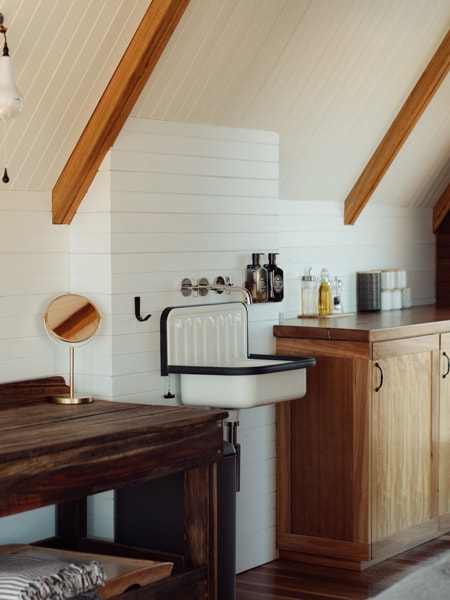
The lovely details of Kimo Estate (image: Matt Beaver).
Why are there only 11 biscuits in a packet of Tim Tams? It’s one of life’s great mysteries and I have plenty of time to contemplate it while sitting back and enjoying a Monte Carlo on my private, sweeping balcony at the William Arnott Hotel. A Monte Carlo biscuit that, might I add, comes from a sensibly sized packet of 12. A legitimate pantry staple, Arnott’s is an Australian cultural icon so you can bet your biscuits I was keen to stay at the William Arnott when it opened late last year. Oozing all kinds of charm, the three-suite hotel is housed in the Historic Arnott Bakehouse, located on Morpeth’s picturesque main street in greater Maitland. Built in the 1850s, it was an early baking site of biscuit royalty William and his brother David, and has recently been transformed into a nostalgia-filled stay.
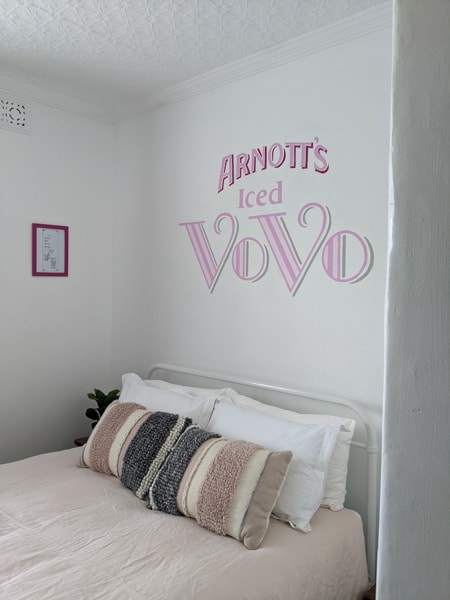
The Iced Vovo room at William Arnott Hotel.
I have the pleasure of occupying the Monte Carlo Penthouse, the premium option thanks largely to its size, classic palette and ornate features. The packet of Monte Carlos on arrival is a lovely touch, and I am two cream-filled biscuits down before you can say, ‘Pop the kettle on’. Downstairs, the VoVo Suite manages to stylishly honour its namesake with pink and maroon touches adorning the family-friendly space. The SAO Studio is small but sweet and, like the entire property, comprises tasteful (pun intended) nods to Bill’s eponymous biccies.
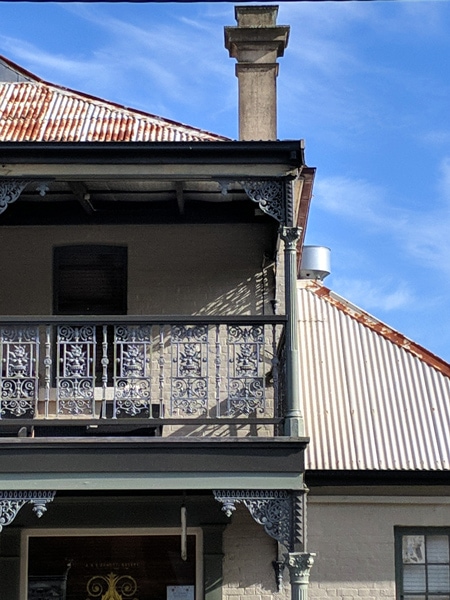
The William Arnott Hotel is full of character, outside and in.
What Stephen and Allison Arnott have created here mirrors what they were themselves seeking when they moved to the area almost 20 years ago: a considered retreat where connection reigns. Rather improbably, the then-Sydneysiders stumbled on the bakehouse while in Morpeth contemplating a tree change. The familial connection (Stephen is William’s great, great, great grandson) was too hard to resist. They asked the owner if he would consider selling and the rest is, quite literally, history. – Kate Symons
All misty mornings and gently rolling hills, Northam is a popular weekend getaway from Perth made even more inviting with the addition of a destination hotel that keys right into the town’s unique heritage. Blending country living with boutique luxury, Farmers’ Home Hotel is the inspired reinvention of a 150-year-old hotel that celebrates the pub’s (sometimes chequered) history. Its opening last year comes after the Dome Group gave the same treatment to the town of Katanning, three hours’ drive south. There, at the Premier Mill Hotel, you can choose to sleep inside an old grain silo, or maybe a packing room, in a boutique hotel that captures the spirit of the building’s industrial heritage.
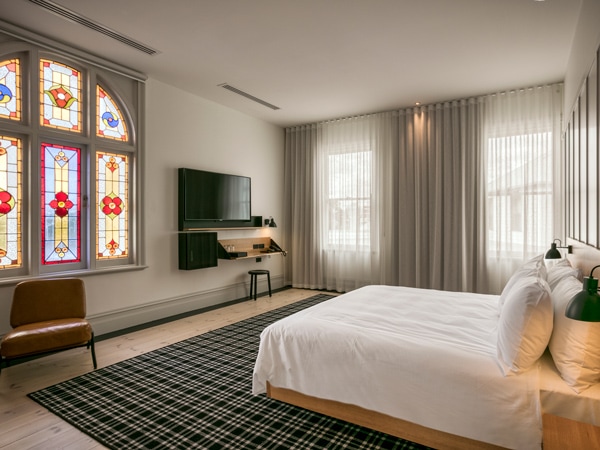
Experience country living with a modern twist at Farmers Home Hotel.
“We get the three K’s here: koalas, kangaroos and kookaburras,” says Vanessa, host of Ardingly Tiny House, a small slice of serenity in Victoria’s Macedon Ranges. From Melbourne, it takes only an hour on the highway to reach the township of Newham, yet it’s far enough for my phone signal to drop out and billboards to give way to gum trees and farm gates. Belonging to the Tiny Away network, Ardingly Tiny House is one of many properties offering low-impact stays in rural areas. I’m staying for a much-needed circuit-breaker. Following the hand-drawn signs down the driveway I find my host, Vanessa, who shows me around the two-hectare property she shares with her husband, son and mini-menagerie of animals, including guinea fowl, ducks and two goats (Rasputin and Zanadu with a z) that live in a shed made from reclaimed materials.

Enjoy a cosy stay in Victoria’s Newham.
The term ‘eco-friendly’ gets bandied around a lot, but this place is the real deal. It’s solar powered, wood heated, and the compact bathroom has a composting toilet. With no wi-fi and patchy phone coverage, I start the fire, then settle in with a book and a beer. After preparing a basic dinner in the kitchen that fits everything I need into a remarkably small space, I climb the ladder leading to the loft bed and lie there drinking in the silence and darkness. In the morning, my breakfast is an apple from one of the property’s trees – a small, simple pleasure, just like my stay at Ardingly Tiny House. – Jo Stewart
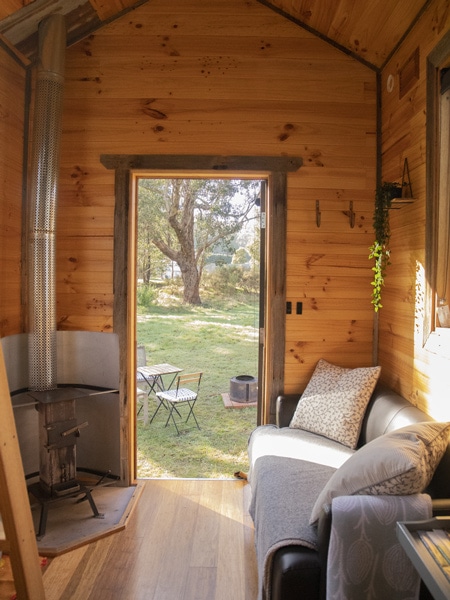
Live simply yet comfortably at Ardingly Tiny Homes.
The sleek silhouette of the restaurant juxtaposes itself against the original red-brick buildings it adjoins. It’s built on the site of the old shearing shed and, with its cement sheeting, brass and leather design cues, takes inspiration from this agricultural heritage. I am a sucker for this kind of adaptive reuse in architecture and – before we even get to the menu showcasing regional produce, or in fact that stunning view over rolling New England paddocks – can see why Glasshouse Restaurant is a destination in itself. It’s just one of the highlights of a stay at Goonoo Goonoo Station: a place for long, slow lunches and even slower weekends.
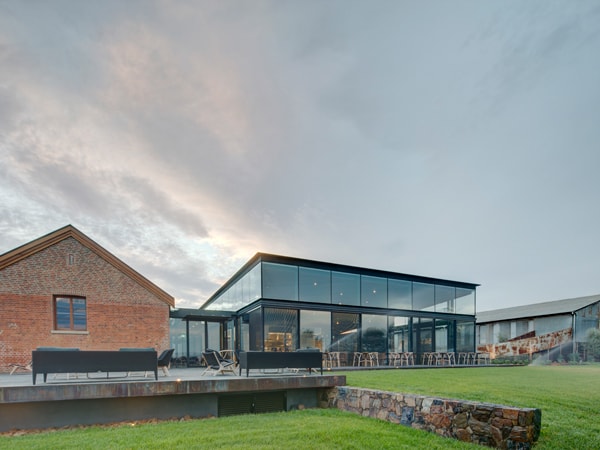
Enjoy a delicious feed at the on-site Glasshouse Restaurant (Image: Goonoo Goonoo Station).
This beautifully restored 19th-century pastoral village, 20 minutes’ drive south of Tamworth, was once a self-sufficient cattle station and one of the most important in NSW. Established in 1841 and home to hundreds of families over the years, today it is a luxury accommodation offering with the aforementioned show-stopping restaurant on site. It’s still a working station, too, with more than 5000 hectares of cattle-grazing pasture. After dinner, it’s a short stroll back down the hill, passing heritage buildings like the chapel and old schoolhouse, to my digs in one of the freestanding cottages, which – with names like The Cook’s House, The Gardener’s Cottage and The Jackaroo’s – speak to the property’s history. All that’s left to do now is wind right down and enjoy the stillness of the countryside from my own private verandah. – Imogen Eveson.
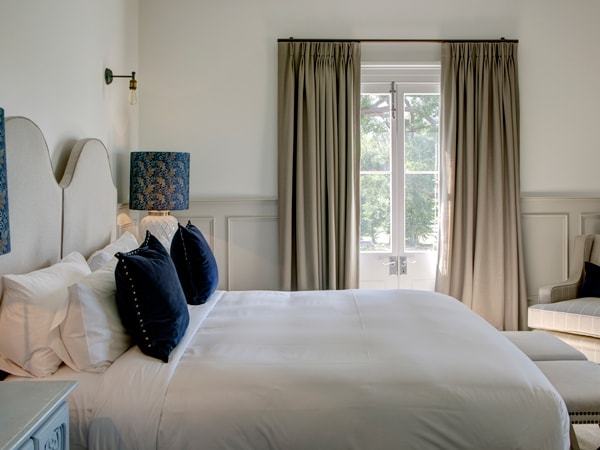
Soak in the stillness of the country at Goonoo Goonoo Station (Image: Goonoo Goonoo Station).
The door swung open and my heart sank. It was picture perfect. You could shoot a romantic movie here; perhaps a remake of Same Time, Next Year where a couple reunite every year to rekindle their affair. The movie takes place in a single hotel suite, but this would be a far more compelling setting. If only I wasn’t here completely alone.
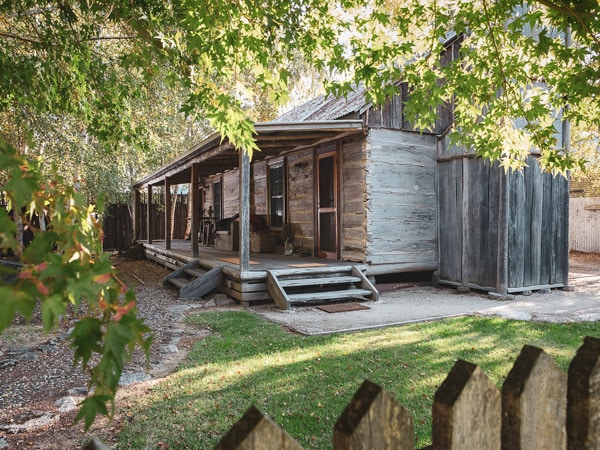
Be transported back to the 1860’s with a luxurious stay at 1860 in Beechworth.
The deep chocolate sofa in front of a stone fireplace is designed for optimal snuggling. The full kitchen is a short slipper-shuffle away. Meanwhile the one bedroom is so cosy it is like being enveloped in the arms of a giant teddy bear. And there’s a bathtub so deep you can sit straight and still have the water come up under your chin. And what makes this intimate haven so alluring is the bare timber walls. Not dark overbearing panelling, but real Australian bush timber.
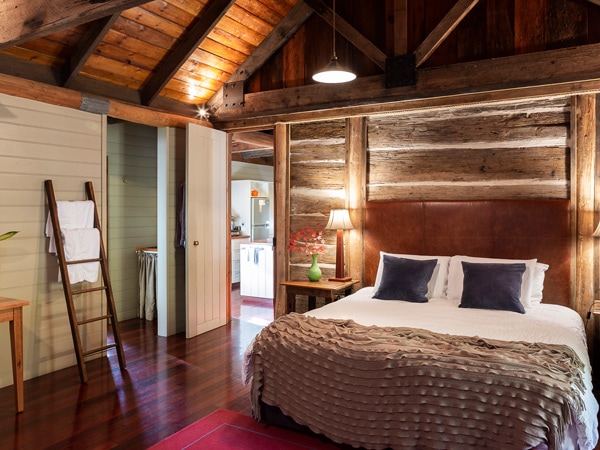
The 1860 cottage has all the essentials for a romantic getaway.
The cottage was built in 1860 (hence the name) from local timbers and is the quintessential highland hut. The structure was dismantled piece by piece and then reassembled with every piece being restored back to its original place. Clancy could have built and lived in this refuge, although he would never have gone droving if it was as sumptuous as it is today. So, there’s no romance during my stay, but I do make the most of the ‘me time’. Same time, next year perhaps. – Quentin Long
There’s a tangible connection the past at Brickendon, especially after 4pm when day visitors leave The World Heritage-listed farm and estate was settled by William Archer in 1824 and now, nearly two centuries later and still with a working farm, descendants Richard and Louise Archer have opened the gates to overnight guests.
I’ve thrown my bags down in the Old Farm Cottage, one of three cottages built in the 1830s by English convicts – men like James Dooley who was sentenced to 14 years for pilfering eight handkerchiefs or the unfortunate John Welch who got life for stealing bacon and cheese (who could blame him?). A free settler, Archer was assigned hundreds of convicts to help build and run the place and, unlike at Port Arthur, convicts here were treated relatively kindly. To wander the village is a step back in time. It’s remarkably raw and free of barriers, as though the original inhabitants might return at any moment.
In William’s first cottage (before the main house was completed) is his suitcase and a single bed with a worn feather doona. There’s a tiny brick chapel, a cookhouse, an array of barns, shearing shed and a blackmith’s shop, untouched since tools were downed in the 1930s. Guests are free to roam and the heritage gardens, set around the Georgian manor, are like a little piece of England with oaks, elms and flowers. As darkness falls on the countryside, there’s even less reminders of the 21st century. My accommodation, once the overseer’s cottage and dairy, combines all the mod cons with old-world style. Door frames encourage ducking. The open wood fire, cleverly set to ignite with a single match, crackles and pops comfortingly as I pour a glass of port from the decanter on the dresser and imagine another time. – Laura Waters
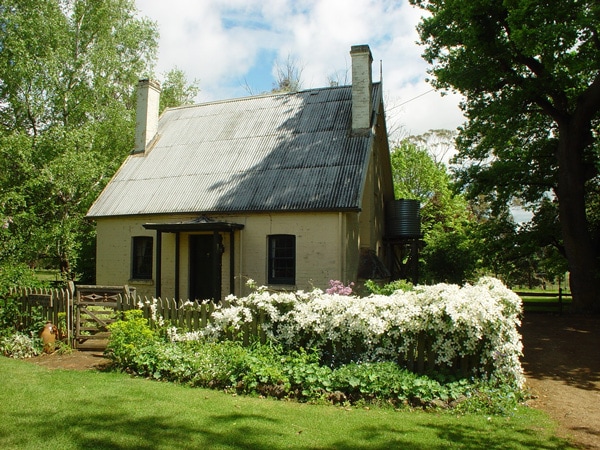
The beautifully historic Old Farm Cottage.
Armidale’s debonair Tattersalls Hotel is perhaps the most underrated time warp in all of country-town Australia. The Victorian-era gold-rush hotel received its first Art Deco makeover back in the 1930s, but a 2019 refurb by Sydney-based interior design studio Luchetti Krelle is next-level artisanship. The tight detail in every room and public space of the three-storey building, from exquisite geometric rugs to top-shelf parquetry, is an Arts Décoratifs eye-bath.
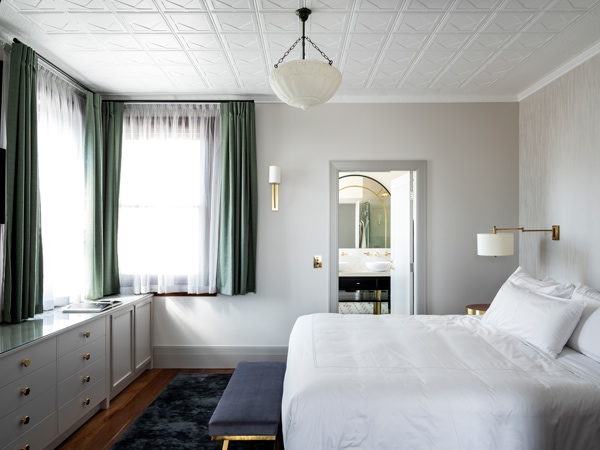
The modern interior of the Chancellors suite.
Featuring deep, soft bespoke furnishings, graceful drapery, subtle metallic highlights and French-washed walls, the Chancellor’s and Governor’s Suites are refined chambers of retrospective excellence. The ground-floor restaurant (headed by chef Jean-Luc Morcellet) is a natural centrepiece and gathering place, its modern-classic food and cocktails making it one of New England’s culinary highlights. – Steve Madgwick
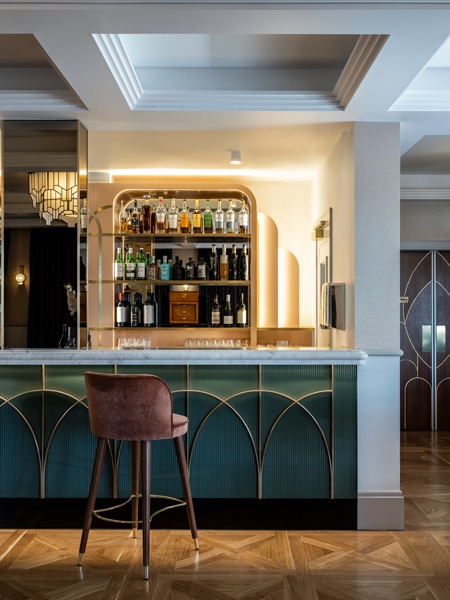
Enjoy a drink at Tattersalls Bar.
From the moment I ‘tie up’ my 4WD next to the log cabin on the lake, 20 minutes from Jindabyne, I feel as though I’ve entered a parallel universe. A gaggle of chooks and a border collie rush out to greet me, and a rocking chair snuggles up one end of the verandah. Suddenly I am The Woman from Snowy River, and I am home. It’s a clever place that manages to merge authentic pioneer style with luxury but the Lake Hut does it.
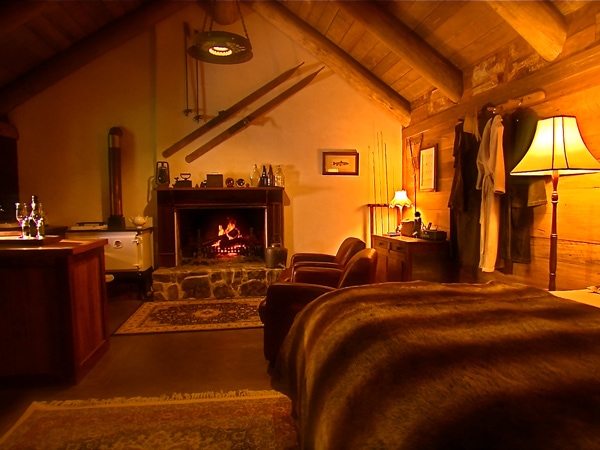
Escape the Snowy Mountains cold at the Moonbah River Hut.
Beyond the rustic wooden door (there are even tiny gaps at the bottom of it) are wood and stone walls, hessian sack curtains and a wood-fired cooking stove. A homely kitchen dresser contains genuinely old crockery and bone-handled cutlery. But it’s also a place with a deeply cosy bed with electric blanket, luxury sheets and faux-fur throws, and the huge stone fireplace keeps the polished concrete floor releasing heat all night long. It’s charming in the extreme and with a corrugated iron-lined en suite, there’s no running to the outhouse at 2am. To say it transports you to another place and time is an understatement.
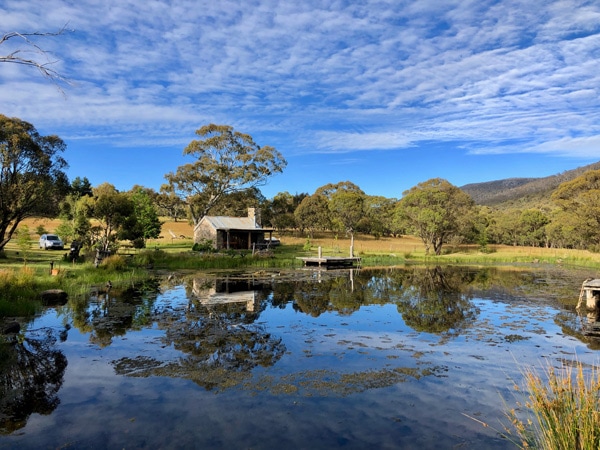
Retreat and breathe in the fresh air at Moonbah (Image: Laura Waters).
Moonbah Huts is somewhere to hole up with a loved one, explore the Snowy Mountains, or just kick back on the verandah and read a book. The fly-fishing in the Moonbah River, a few minutes’ walk away, is world-class, but the private trout-filled lake on my doorstep is where I have my first try at casting. Owner and fishing expert Brett Smith reckons they ‘always’ catch a fish during a two-hour lesson. I don’t even get a bite but with so much serenity around me it doesn’t matter one bit. – Laura Waters
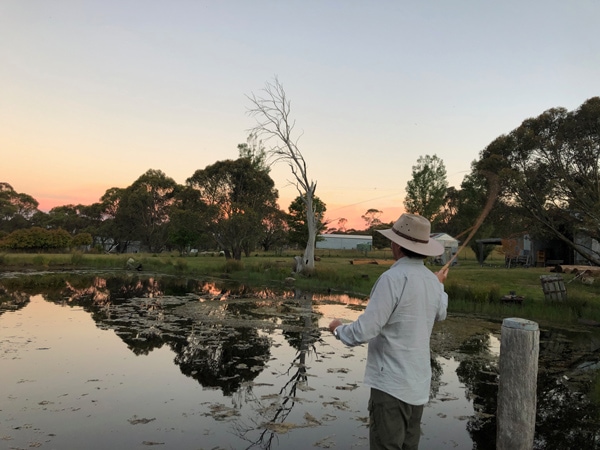
Moonbah is on a world renowned fishing spot (image: Laura Waters).
LEAVE YOUR COMMENT